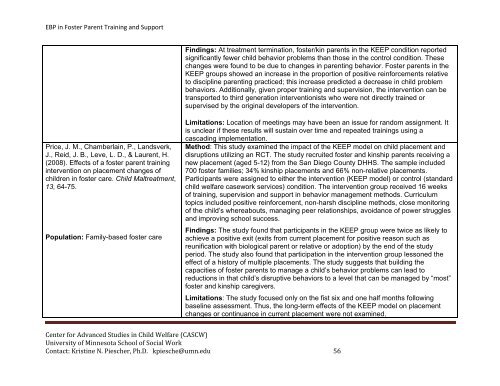Evidence-Based Practice in Foster Parent Training and Support ...
Evidence-Based Practice in Foster Parent Training and Support ...
Evidence-Based Practice in Foster Parent Training and Support ...
Create successful ePaper yourself
Turn your PDF publications into a flip-book with our unique Google optimized e-Paper software.
EBP <strong>in</strong> <strong>Foster</strong> <strong>Parent</strong> Tra<strong>in</strong><strong>in</strong>g <strong>and</strong> <strong>Support</strong>F<strong>in</strong>d<strong>in</strong>gs: At treatment term<strong>in</strong>ation, foster/k<strong>in</strong> parents <strong>in</strong> the KEEP condition reportedsignificantly fewer child behavior problems than those <strong>in</strong> the control condition. Thesechanges were found to be due to changes <strong>in</strong> parent<strong>in</strong>g behavior. <strong>Foster</strong> parents <strong>in</strong> theKEEP groups showed an <strong>in</strong>crease <strong>in</strong> the proportion of positive re<strong>in</strong>forcements relativeto discipl<strong>in</strong>e parent<strong>in</strong>g practiced; this <strong>in</strong>crease predicted a decrease <strong>in</strong> child problembehaviors. Additionally, given proper tra<strong>in</strong><strong>in</strong>g <strong>and</strong> supervision, the <strong>in</strong>tervention can betransported to third generation <strong>in</strong>terventionists who were not directly tra<strong>in</strong>ed orsupervised by the orig<strong>in</strong>al developers of the <strong>in</strong>tervention.Price, J. M., Chamberla<strong>in</strong>, P., L<strong>and</strong>sverk,J., Reid, J. B., Leve, L. D., & Laurent, H.(2008). Effects of a foster parent tra<strong>in</strong><strong>in</strong>g<strong>in</strong>tervention on placement changes ofchildren <strong>in</strong> foster care. Child Maltreatment,13, 64-75.Population: Family-based foster careLimitations: Location of meet<strong>in</strong>gs may have been an issue for r<strong>and</strong>om assignment. Itis unclear if these results will susta<strong>in</strong> over time <strong>and</strong> repeated tra<strong>in</strong><strong>in</strong>gs us<strong>in</strong>g acascad<strong>in</strong>g implementation.Method: This study exam<strong>in</strong>ed the impact of the KEEP model on child placement <strong>and</strong>disruptions utiliz<strong>in</strong>g an RCT. The study recruited foster <strong>and</strong> k<strong>in</strong>ship parents receiv<strong>in</strong>g anew placement (aged 5-12) from the San Diego County DHHS. The sample <strong>in</strong>cluded700 foster families; 34% k<strong>in</strong>ship placements <strong>and</strong> 66% non-relative placements.Participants were assigned to either the <strong>in</strong>tervention (KEEP model) or control (st<strong>and</strong>ardchild welfare casework services) condition. The <strong>in</strong>tervention group received 16 weeksof tra<strong>in</strong><strong>in</strong>g, supervision <strong>and</strong> support <strong>in</strong> behavior management methods. Curriculumtopics <strong>in</strong>cluded positive re<strong>in</strong>forcement, non-harsh discipl<strong>in</strong>e methods, close monitor<strong>in</strong>gof the child’s whereabouts, manag<strong>in</strong>g peer relationships, avoidance of power struggles<strong>and</strong> improv<strong>in</strong>g school success.F<strong>in</strong>d<strong>in</strong>gs: The study found that participants <strong>in</strong> the KEEP group were twice as likely toachieve a positive exit (exits from current placement for positive reason such asreunification with biological parent or relative or adoption) by the end of the studyperiod. The study also found that participation <strong>in</strong> the <strong>in</strong>tervention group lessoned theeffect of a history of multiple placements. The study suggests that build<strong>in</strong>g thecapacities of foster parents to manage a child’s behavior problems can lead toreductions <strong>in</strong> that child’s disruptive behaviors to a level that can be managed by “most”foster <strong>and</strong> k<strong>in</strong>ship caregivers.Limitations: The study focused only on the fist six <strong>and</strong> one half months follow<strong>in</strong>gbasel<strong>in</strong>e assessment. Thus, the long-term effects of the KEEP model on placementchanges or cont<strong>in</strong>uance <strong>in</strong> current placement were not exam<strong>in</strong>ed.Center for Advanced Studies <strong>in</strong> Child Welfare (CASCW)University of M<strong>in</strong>nesota School of Social WorkContact: Krist<strong>in</strong>e N. Piescher, Ph.D. kpiesche@umn.edu 56
















